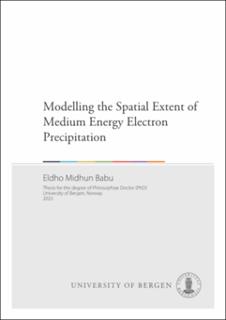| dc.contributor.author | Babu, Eldho Midhun | |
| dc.date.accessioned | 2023-09-07T11:14:59Z | |
| dc.date.available | 2023-09-07T11:14:59Z | |
| dc.date.issued | 2023-09-22 | |
| dc.date.submitted | 2023-08-30T17:36:05.590Z | |
| dc.identifier | container/a9/c8/84/9a/a9c8849a-71ee-4733-b652-78dbb42ac8ed | |
| dc.identifier.isbn | 9788230857908 | |
| dc.identifier.isbn | 9788230858158 | |
| dc.identifier.uri | https://hdl.handle.net/11250/3087921 | |
| dc.description.abstract | Jordens magnetosfære fungerer som et robust skjold, og beskytter planeten vår mot den nådeløse tilstrømningen av ladede partikler som hovedsakelig stammer fra solens solvind og fra de kosmiske strålene utenfor vårt solsystem. Mange av disse ladede partiklene blir fanget av jordens magnetosfære, og danner strålingsbeltene. En betydelig delmengde av disse fangede elektronene med energi >30 keV, kalt Medium Energy Electrons (MEE), dykker dypt inn i atmosfæren vår, og påvirker atmosfærisk kjemi og dynamikk direkte. Virkningen av MEE-nedbør på klimaet har blitt et voksende område av vitenskapelig interesse, spesielt gitt dens potensielle rolle i å ødelegge stratosfærisk og mesosfærisk ozon. Denne forskningen fordyper seg i å forstå den romlige fordelingen av MEE-nedbør og dens bredere implikasjoner. Ved å utnytte data fra Medium Energy Proton Electron Detector (MEPED) på ulike satellitter og sammenligne dem med geomagnetiske indekser, presenterer oppgaven en omfattende modell for å forutsi den geografiske omfanget av MEE-nedbør. | en_US |
| dc.description.abstract | The Earth's magnetosphere acts as a robust shield, protecting our planet from the relentless influx of charged particles originating primarily from the Sun's solar wind and from the cosmic rays beyond our solar system. Many of these charged particles get trapped by the Earth’s magnetosphere, forming the radiation belts. A significant subset of these trapped electrons with energy >30 keV, termed Medium Energy Electrons (MEE), dive deep into our atmosphere, directly influencing atmospheric chemistry and dynamics. The impact of MEE precipitation on the climate has become an emerging area of scientific interest, particularly given its potential role in destroying stratospheric and mesospheric ozone. This research delves into understanding the spatial distribution of MEE precipitation and its broader implications. Leveraging data from the Medium Energy Proton Electron Detector (MEPED) on various satellites and comparing it to geomagnetic indices, the thesis presents a comprehensive model to predict the geographic extent of MEE precipitation. | en_US |
| dc.language.iso | eng | en_US |
| dc.publisher | The University of Bergen | en_US |
| dc.relation.haspart | Paper I: Babu, E. M., Tyss.y, H. N., Smith-Johnsen, C., Maliniemi, V., Salice, J. A., Millan, R. M., & Richardson, I. G. (2022). Determining latitudinal extent of energetic electron precipitation using MEPED on-board NOAA/POES. Journal of Geophysical Research: Space Physics, 127, e2022JA030489. The article is available at: <a href="https://hdl.handle.net/11250/3028223" target="blank">https://hdl.handle.net/11250/3028223</a>. | en_US |
| dc.relation.haspart | Paper II: E.M. Babu, H. Nesse, S.M. Hatch, N. Olsen, J.A. Salice, and I.G. Richardson. An Updated Geomagnetic Index-based Model for Determining the Latitudinal Extent of Energetic Electron Precipitation. Not available in BORA. | en_US |
| dc.relation.haspart | Paper III: H. Nesse, E.M. Babu, J.A. Salice, and B. Funke. Energetic Electron Precipitation during Slot Region Filling Events. Not available in BORA. | en_US |
| dc.relation.haspart | Paper IV: Tyssøy HN, Partamies N, Babu EM, Smith-Johnsen C and Salice J (2021) The Predictive Capabilities of the Auroral Electrojet Index for Medium Energy Electron Precipitation. Front. Astron. Space Sci. 8:714146. The article is available at: <a href="https://hdl.handle.net/11250/2979653" target="blank">https://hdl.handle.net/11250/2979653</a>. | en_US |
| dc.relation.haspart | Paper V: Salice, J. A., Nesse, H., Babu, E. M., Smith-Johnsen, C., & Richardson, I. G. (2023). Exploring the predictability of the high-energy tail of MEE precipitation based on solar wind properties. Journal of Geophysical Research: Space Physics, 128, e2022JA031194. The article is available in the thesis. The article is also available at: <a href="https://doi.org/10.1029/2022JA031194" target="blank">https://doi.org/10.1029/2022JA031194</a>. | en_US |
| dc.rights | In copyright | |
| dc.rights.uri | http://rightsstatements.org/page/InC/1.0/ | |
| dc.title | Modelling the Spatial Extent of Medium Energy Electron Precipitation | en_US |
| dc.type | Doctoral thesis | en_US |
| dc.date.updated | 2023-08-30T17:36:05.590Z | |
| dc.rights.holder | Copyright the Author. All rights reserved | en_US |
| dc.contributor.orcid | 0000-0002-6092-5828 | |
| dc.description.degree | Doktorgradsavhandling | |
| fs.unitcode | 12-24-0 | |
